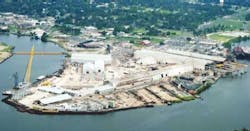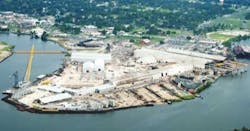Ocean bottom seismic a key technology offshore West Africa
Kim Gunn Maver
RXT
Seabed seismic data acquisition can be applied to many seismic and geological challenges and may improve reservoir characterization and management. The technology has in recent years become strategic for many oil companies in their de-risking of wells and recovery factor improvement.
By placing sensors on the seafloor and decoupling the source and receiver, the acquisition layout and equipment ensures a number of benefits and it proves ocean bottom seismic (OBS) delivers results unique to this technology while resolving many streamer seismic limitations.
This strategic application is seen in West Africa where RXT has been acquiring ocean bottom cable (OBC) seismic since 2007 in Nigeria, working for clients like Afren, MPN (ExxonMobil Nigeria), Chevron, and Total.
RXT acquires OBC seismic using a number of steel cables connected to an autonomous buoy that records all data, making it possible to retrieve that data without retrieving the cable. Every 25 to 50 m (82 to 164 ft) along the VectorSeis Ocean (VSO) cable is a hydrophone and three orthogonal geophones or accelerometers on the seafloor acquiring 4C data.
Among the benefits of 4C is that both compressional data (PP) and converted shear wave data (PS) volume are acquired. The PP data consists of a downgoing compressional wave that is reflected and recorded as a compressional wave at the seabed. The PS data consists of a downgoing compressional wave that is reflected and converted as shear wave and recorded at the seabed.
Placing sensors at the seafloor has benefits. Two sources of noise that impact both data quality and operational performance of towed streamer surveys are avoided by placing sensors on the seafloor. Both the noise arising from towing the sensors through the water, as well as the noise induced by the movement of the sea surface, is eliminated. Using both the geophone and hydrophone data gives a straight-forward process to separate the recorded data into upward and downward traveling components that can be used efficiently in multiple elimination. By placing the sensors on the seabed, optimal coupling also is achieved. With a shorter ray path, OBC provides superior bandwidth compared to streamer data.
These benefits of OBC seismic can be achieved in highly obstructed areas because it is possible to deploy cables close to the subsurface and surface infrastructure for better data coverage and it reduces the need for undershooting.
To improve imaging in complex geology and salt structures, OBC provides the opportunity for wide-azimuth and full-azimuth designs, as there is a lot of flexibility in how to place the receiver arrays relative to the source arrays. Multiple vessels and passes are not required with OBC to acquire wide-azimuth data, making OBC competitive with streamer data.
Because converted shear waves are acquired, the issue of gas clouds can be resolved as the shear waves are insensitive to gas and can image both within and below the cloud. The insensitivity of the shear waves to both oil and gas provides a unique hydrocarbon prediction attribute as well. Compressional data is influenced by hydrocarbons, however, the converted shear wave data will not be. Therefore, it is possible to separate a lithological/diagenetic effect and hydrocarbons, as an amplitude brightening on the PP data will only be a hydrocarbon effect if not also present on the PS data.
With benefits such as better seismic reservoir characterization using seismic inversion, the application of OBS as a strategic technology to solve similar seismic challenges to those of West Africa will increase especially as many of the oil field challenges that are also seen in West Africa can be resolved by OBS.
Offshore Articles Archives
View Oil and Gas Articles on PennEnergy.com


